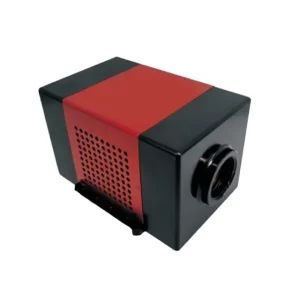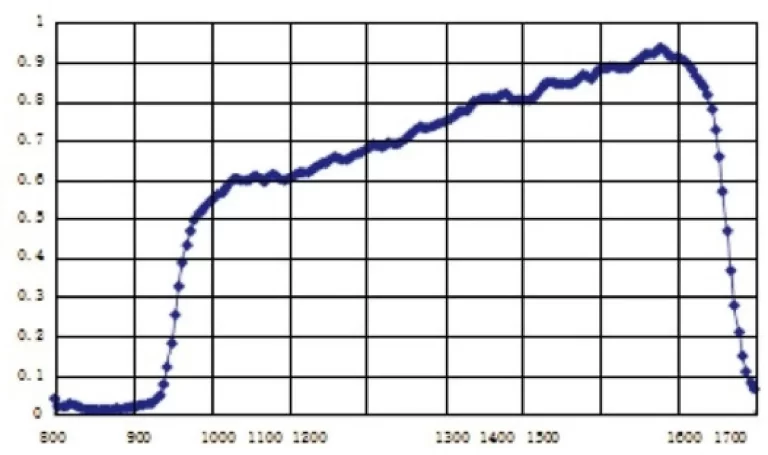Overview and Applications
InGaAs SPAD 8×8 Array Module OP520C is an advanced single-photon detector module featuring a densely packed 8×8 pixel array of indium gallium arsenide avalanche photodiodes (InGaAs APDs) operating in Geiger mode (SPAD). Designed for ultra-sensitive detection in the short-wave infrared (SWIR) range, it covers wavelengths from 1000 nm to 1650 nm, making it ideal for telecom-band applications (e.g. 1550 nm) as well as eye-safe LiDAR at 1064 nm. Each pixel in the 64-channel array is an independent SPAD sensor capable of detecting individual photons, supported by integrated active quenching and cooling electronics. This module delivers high detection sensitivity for weak optical signals and is tailored for long-range optical systems and scientific experiments in fields such as:
- Optical Communication: Single-photon reception in free-space or fiber-based telecom networks (C-band) and quantum key distribution.
- LiDAR & Laser Ranging: Eye-safe long-distance LiDAR at 1550 nm or 1064 nm, enabling high-fidelity time-of-flight measurements for autonomous vehicles or aerospace mapping.
- Quantum Optics & Sensing: Single-photon counting for quantum optics experiments, entangled photon detection, and time-correlated measurements (e.g. fluorescence lifetime imaging, time-resolved spectroscopy).
- 3D Imaging & Time-of-Flight Cameras: Multi-pixel SPAD arrays allow parallel detection for low-light 3D imaging, depth sensing, and multi-target tracking in demanding photon-starved scenarios.
The OP520C’s design (100 × 74 × 62 mm, ~450 g) is integration-ready – combining the SPAD sensor array with all necessary support circuitry (bias generation, active quenching for each pixel, timing logic, and the thermoelectric cooler) in one module. Users can interface with it via a high-speed serial port for configuration, and capture TTL-level pulse outputs (5 V amplitude) from each pixel for direct timing or counting measurements. By providing a turnkey single-photon detector array in the NIR, the OP520C allows engineers and researchers to deploy sophisticated photon-counting systems without needing to develop custom quenching circuits or cryogenic cooling setups.
Key Features and Specifications
- 8×8 Pixel InGaAs SPAD Array: 64 independent SPAD detectors arranged on a 0.4 × 0.4 mm photosensitive area (50 μm pixel pitch). The fine pixel pitch enables higher spatial resolution and dense packing compared to many research-grade NIR SPAD arrays – for instance, Hamamatsu’s early 32×32 InGaAs prototypes used a coarser ~100 μm pitch (recently improved to ~55 μm).
- Telecom-Band Sensitivity (1000–1650 nm): High quantum efficiency in the SWIR range covering common communication and LiDAR wavelengths. The array achieves a photon detection efficiency ~15% at 1550 nm (typical bias), and maintains solid efficiency at 1064 nm – enabling single-photon detection for eye-safe lasers. A built-in filter mount allows use of bandpass filters to isolate specific wavelengths if needed.
- Low Noise & High Dynamic Range: Each pixel’s InGaAs avalanche photodiode is cooled (to approx. –30 °C) to suppress thermal noise. Typical dark count rates are ≤ 10 kHz per pixel at 1550 nm (at PDE ≈10%), and can be as low as 5 kHz in optimized conditions (e.g. using an InGaAsP absorber optimized for ~1064 nm). The array’s design also minimizes crosstalk and afterpulsing, with an afterpulse probability of ~20% at nominal settings – suitable for high-frequency counting without excessive false triggers.
- Flexible Gating and Timing Control: The OP520C supports free-running or externally gated operation. User-adjustable parameters include the detector bias threshold (50 V to 85 V), active quench comparator level, dead time (0.1–2.0 µs) to mitigate afterpulses, and gate window width & period (down to 0.1 µs). This flexibility allows tuning the detector for either maximum sensitivity or highest count rate, depending on application needs. All settings are configured via a digital interface (115200 baud serial) and can be optimized in real-time to suit different experimental conditions.
- Integrated Thermoelectric Cooling: A multi-stage TEC and temperature sensor are built in, allowing the SPAD array to operate at temperatures from -30 °C to +30 °C (user-settable in 0.1° increments). Cooling the InGaAs SPADs dramatically reduces dark noise – enabling the specified low DCR in the 10^4 counts/s range – and stabilizes performance over long sessions. The module’s power consumption is ~15 W (typical) when holding -30 °C, powered by a single 12 V DC supply (up to 30 W under max load).
- Output and Readout: Each SPAD pixel outputs a discrete digital pulse (~5 V, TTL) upon detecting a photon. This allows straightforward readout with standard timing electronics or FPGAs. The independent channel outputs (with no internal multiplexing) enable parallel photon timing – e.g. capturing multiple simultaneous photon events or imaging a sparse scene. Sub-nanosecond timing precision on each channel makes the array suitable for time-correlated single photon counting (TCSPC) and LiDAR depth calculations with sub-centimeter resolution.
- Compact, Rugged Design: Housed in a robust metal enclosure, the OP520C module is roughly the size of a small camera. It weighs about 0.45 kg and features mounting points for easy attachment to optical setups or instruments. The SPAD array is sealed behind an optical window or lens mount on the front, protecting it from ambient moisture and light interference. The device is rated for ambient temperatures from -40 °C to +55 °C, ensuring reliability in both lab and field conditions.
To summarize the core specifications, the table below highlights the OP520C’s key parameters:
| Parameter | Value |
|---|---|
| Array format | 8 × 8 pixels (InGaAs SPAD array) |
| Pixel pitch / Active area | 50 μm pitch (0.4 × 0.4 mm active area) |
| Spectral response | 1000 nm – 1650 nm (near-infrared) |
| Photon detection efficiency | ~15% @ 1550 nm (typical per pixel) |
| Dark count rate | ≤ 10 kHz per pixel (InGaAs, at PDE=10%); ≤ 5 kHz (InGaAsP variant) |
| Afterpulse probability | ~20% (at PDE=10%, 0.8 µs dead time) |
| Dead time (adjustable) | 0.1 µs – 2.0 µs (user settable) |
| Gate width / period | ≥ 0.1 µs width; > 0.1 µs period (adjustable) |
| Operating temperature | -30 °C to +30 °C (TEC setpoint); -40 °C to +55 °C ambient |
| Output signal | 5.0 V logic pulses (TTL, per pixel) |
| Control interface | Serial UART (115200 baud) for parameter control |
| Power supply | 12 V DC (approx. 1.2 A draw) |
| Power consumption | ~15 W (typical at -30 °C); 30 W max |
| Module dimensions | 100 × 74 × 62 mm |
| Module weight | ~450 g |
Performance and Characteristic Curves
The spectral response curve above illustrates the OP520C’s efficiency across its operating band. Sensitivity rises sharply beyond ~950 nm as the InGaAs absorption layer becomes active, and it reaches a broad plateau through the 1300–1600 nm region. At 1550 nm, each pixel typically achieves ~15% photon detection efficiency, balancing quantum efficiency with low noise. Even at the shorter wavelength end (~1064 nm), the array provides significant response – an InGaAsP option optimized for 1064 nm is available, which offers similar PDE but with even lower dark counts (~5 kHz per pixel) thanks to the material’s reduced thermal generation.
Crucially, the noise performance of the OP520C is enhanced by its cooling and customizability. Operating the SPAD array at -30 °C significantly suppresses thermal dark noise, yielding the low kHz-range dark count rates noted above. Users can further optimize SNR by adjusting the dead time (to reduce afterpulsing) or by using a gated mode to blank the detector outside the expected signal window. The recommended dead time of ~0.8 µs effectively balances throughput with afterpulse probability, keeping the latter around 20% – a favorable level for InGaAs SPADs at telecom bias levels. Because each pixel operates independently with its own quench circuit, a bright event on one pixel has negligible impact on neighboring pixels (crosstalk is minimized by design), which ensures reliable multi-pixel operation for techniques like coincidence counting and photon timing across the array.
Another important characteristic is the timing resolution and throughput. Thanks to fast avalanche quenching, each pixel can reset within a few nanoseconds after a detection, supporting count rates on the order of 10^6 counts per second (depending on dead time settings). The precise timing of each output pulse (on the order of a few hundred picoseconds timing jitter, typical for cooled InGaAs SPADs) enables high-resolution time-of-flight measurements and time-correlation experiments. In a gated configuration, the module can synchronize with pulsed laser systems at multi-MHz repetition, capturing return photons within the defined gate and blocking out-of-window dark counts. This capability is vital for applications like 3D LiDAR, where the OP520C can help discern distances by timing photon arrival across its 64 pixels simultaneously.
Integration and Control
Integrating the OP520C into a larger system is straightforward due to its self-contained design and digital control interface. The module requires a single 12 V DC supply and provides 64 parallel digital outputs (one per pixel) that can be connected to a timing acquisition system or photon-counting electronics. A computer or microcontroller can communicate with the OP520C via its serial UART interface to set parameters such as bias voltage, temperature setpoint, dead time, and gate timing. This means that users can dynamically tune the detector for different conditions or perform calibration routines remotely.
The compact form factor and moderate power requirements allow the OP520C to be deployed both in laboratory setups and in the field. For example, in a free-space quantum communication experiment, the OP520C can serve as the receiver’s detector array, counting single photons from a distant transmitter at 1550 nm. The built-in TEC maintains the array at low temperature through daily temperature swings, ensuring consistent sensitivity and noise performance. In a LiDAR application, multiple pixels of the 8×8 array could be mapped to different angles or segments of a scene, enabling parallel detection of returns and increasing the system’s spatial coverage per laser pulse. Each pixel’s TTL output can feed into a time-to-digital converter (TDC), allowing the construction of a depth map from the measured time-of-flight of photons across the array.
Because the OP520C integrates all biasing, quenching, and cooling internally, it offers plug-and-play simplicity compared to traditional single-pixel SPAD setups. There is no need to manually tune bias voltages or gate timing with external circuits – once configured, the module self-regulates these parameters. The sealed, rugged enclosure further simplifies integration, protecting the sensitive detector array from environmental light and contamination. Essentially, using the OP520C is akin to using a high-performance camera sensor, but for single photons in the infrared: provide power and data connections, and the module delivers actionable digital photon counts.
Comparison to Competing SPAD Solutions
In the niche realm of NIR SPAD arrays, the OP520C sets itself apart as a readily available 64-pixel InGaAs SPAD module with a combination of features not found elsewhere:
- Hamamatsu Photonics: Hamamatsu has pioneered both silicon and InGaAs SPAD sensors, but currently offers no off-the-shelf equivalent to the OP520C’s multi-pixel NIR detector. Hamamatsu’s multi-pixel photon counter arrays (MPPC, SiPM technology) are silicon-based (for example, an 8×8 MPPC array with 50 μm pixels covers 320–900 nm) – excellent for visible-light photon counting, but ineffective at 1550 nm.
- Micro Photon Devices (MPD): MPD specializes in InGaAs SPAD modules, especially gated single-pixel detectors with low noise. However, their offerings (e.g. the PDM series) typically involve single SPADs or a few synchronized channels rather than two-dimensional arrays. MPD has developed SPAD arrays for research (including high-speed SPAD imagers for visible wavelengths), but an 8×8 InGaAs SPAD module with the OP520C’s level of integration and user control is not available in their standard portfolio. In practice, achieving similar multi-pixel capability with MPD’s units would require coordinating multiple detectors and external gating electronics, whereas the OP520C provides a unified solution.
- Excelitas Technologies: Excelitas (formerly PerkinElmer) produces a wide range of avalanche photodiodes and single-photon counters, including the well-known SPCM series (silicon SPAD modules). For near-infrared, Excelitas offers discrete InGaAs APDs and has worked on gated single-photon detector devices, but as of now there is no directly comparable multi-pixel InGaAs SPAD product in their catalog. Most competing solutions in the telecom band are either single-element detectors or custom arrays developed for specific projects. The OP520C, with its integrated 8×8 array, TEC cooling, and tunable parameters, stands virtually alone as a commercial off-the-shelf component that developers can readily incorporate for NIR photon-counting applications.
In summary, the OP520C InGaAs 8×8 SPAD Array Component delivers a unique blend of high performance and ease of integration for demanding photonics applications. Its fine pixel pitch, telecom-wavelength sensitivity, low noise, and flexible user control give it clear advantages in optical communication, LiDAR, quantum photonics, and beyond. This module enables cutting-edge experimentation and product development in environments where detecting every single photon matters, all while simplifying the setup and reducing time-to-integration for system builders.
Sources: Lontenoe (OP520C product page); OP520C datasheet; Lontenoe technical overview; Hamamatsu & Excelitas product literature.







